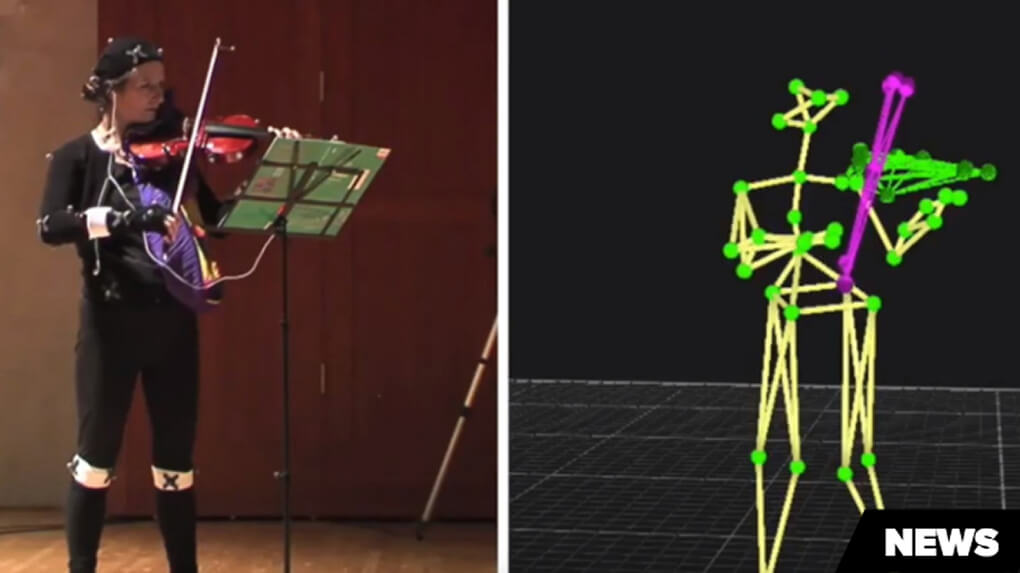
Playing the violin is a subtle art. Anyone can learn the basics of fingering and bowing, but what is it that sets apart an adequate or competent player from a virtuoso? It’s all in the details.
While AI may not be able to play the instrument on its own — just yet — a newly developed system may help students perfect their bowing techniques. The system was built by researchers at the Pompeu Fabra University in Barcelona, Spain., and documented in a paper that was published in Frontiers in Psychology in March.
Scientists David Dalmazzo and Rafael Ramírez of the University’s Music and Machine Learning Lab of the Music Technology Group (MTG) at the Department of Information and Communication Technologies (DTIC) produced an artificial intelligence system that records and analyzes a violinist’s movements in real time. They explain the basic rationale in a media release.
“We recorded movement and audio data corresponding to seven representative bow techniques (Détaché, Martelé, Spiccato, Ricochet, Sautillé, Staccato and Bariolage) performed by a professional violinist. We obtained information about the inertial motion from the right forearm and we synchronized it with the audio recordings.”
The gestures used in bowing are crucial to the quality of sound and expression that the musician produces. The scientists used motion capture technology attached to professional violinist Madeleine Mitchell, in collaboration with the Royal College of Music, London, who demonstrated each of the seven techniques as reference points. She played all the gestures in G major in order to cover three octaves for the study. Within the seven gestures, a total of 8,020 samples were recorded. The system analyzes several components of the sound that is produced, in order to focus only on those related to the musician’s gestures.
The results? By analyzing the motion of the right hand together with the sound produced, the AI system was able to identify the nature of the bowing technique with 94 percent accuracy.
A violinist’s gestures and movements are crucial, including the minute details of how the bow is held and moves across the strings. Any musician’s technique depends on motor abilities that the body learns by repetition. Eventually, the movements become instinctive.
The goal of the AI system overall is to be able to help violin students perfect their bowing techniques with real-time feedback. Similar technology is already used in areas like professional sports. In professional golfer’s clubs, there is a built-in program that analyzes the swing mechanics and provides feedback after play. Eventually, violins and other instruments could be built to already include similar embedded technology.
The system is a much more viable methodology than prohibitively expensive alternatives such as 3D body reconstruction that uses camera motion tracking rooms, or electromagnetic positional tracking systems. Here, the violinist can simply wear the motion capture device, which is a highly sensitive device called Myo. Myo is worn as a bracelet, adjusts to the size of the violinist’s forearm, and weighs only 93 grams or about 3.3 ounces.
The same research team plans future experiments where the sensors are embedded into both the bow and violin, a technique to measure the violinist’s standing posture, as well as developing a computer app for the process.
LUDWIG VAN TORONTO
Want more updates on classical music and opera news and reviews? Follow us on Facebook, Instagram or Twitter for all the latest.
- PREVIEW | Creators & Performers Natalya Gennadi And Kristine Dandavino Talk About Grandma’s Shawl - April 26, 2024
- PREVIEW | Artistic Director Emily Cheung Dives Into Little Pear Garden Dance Company’s History & 30th Anniversary Peformance - April 26, 2024
- LEBRECHT LISTENS | Tim Posner And The Berne Symphony Find The Pleasure Spot In Bloch, Bruch, Dohnányi - April 26, 2024



